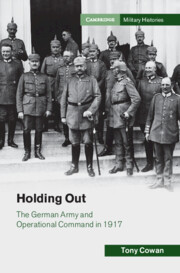Book contents
- Holding Out
- Cambridge Military Histories
- Holding Out
- Copyright page
- Dedication
- Contents
- Figures
- Maps
- Tables
- Acknowledgements
- Comparative Ranks
- Chronology
- Abbreviations
- General key to maps
- Introduction
- 1 Context
- 2 Principles
- 3 Organisation
- 4 Personality
- 5 Intelligence
- 6 Communication
- 7 Learning
- 8 Performance
- Conclusion
- Bibliography
- Index
- Holding Out
- Cambridge Military Histories
- Holding Out
- Copyright page
- Dedication
- Contents
- Figures
- Maps
- Tables
- Acknowledgements
- Comparative Ranks
- Chronology
- Abbreviations
- General key to maps
- Introduction
- 1 Context
- 2 Principles
- 3 Organisation
- 4 Personality
- 5 Intelligence
- 6 Communication
- 7 Learning
- 8 Performance
- Conclusion
- Bibliography
- Index
Summary
The German army viewed war as the realm of constant uncertainty. Reducing this was the third command task, principally through intelligence on the enemy and information on German troops (Chapter 6). By 1917, loss of the initiative and the need to deploy scarce resources efficiently had boosted German military intelligence’s importance. Its dense network of sources. Poor integration and frequent squabbles between intelligence producers, but also effective informal co-operation, including extensive use of civilians. The tiny Intelligence Department in OHL (Supreme Army Command) produced all-source assessments used extensively by decision-makers, but performance on total war political and economic requirements was inadequate despite recruitment of high-level agents.
Case study of German intelligence’s mixed performance in spring 1917. Good intelligence played a central role in the German victory over the French assault by enabling timely concentration of forces; but uncertainty about British plans was a major factor in delaying defensive preparations, leading to the initial defeat at Arras.
Keywords
- Type
- Chapter
- Information
- Holding OutThe German Army and Operational Command in 1917, pp. 156 - 189Publisher: Cambridge University PressPrint publication year: 2023

